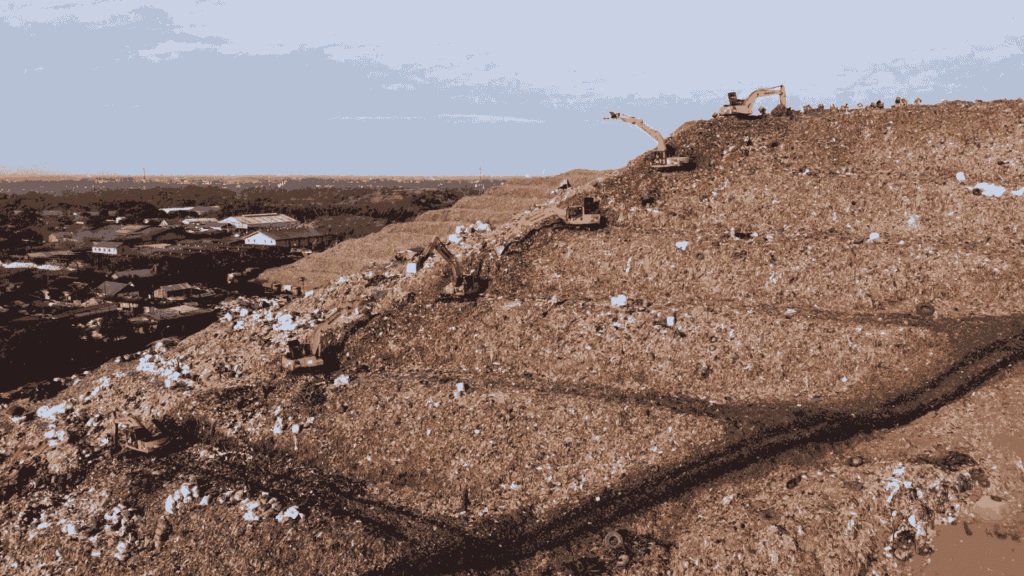Piles of garbage in the Bantargebang landfill stands as tall as a 16-story building, with 7,500 tonnes of waste added daily.
The condition of the Bantargebang Integrated Waste Treatment Site (TPST) is increasingly worrying. Piles of garbage in Bantargebang are getting more and more mountainous. Even the heap is said to be equivalent to the height of a 16-story building. “The height of Bantargebang trash is equivalent to a 16-floor building,” wrote this account in the screenshot of the video he embedded. Two years earlier, namely in 2021, the DKI Jakarta Provincial Government (Penprov) had stated that the height of the Bantargebang TPST had reached the maximum limit.
RELEVANT SUSTAINABLE GOALS



History of Bantargebang TPST
Before being designated as TPST (Tempat Pembungan Sampah Terpadu / Integrated Garbage Disposal Sites), Bantargebang was first known as Bantargebang TPA. Reporting to a study entitled Integrated Garbage Disposal Sites (TPST) as an Economic Source for Overseas Communities in the Ciketingudik Bantargebang Village in a Photo Essay, Susiani Saragih (2020), the Bantargebang area was originally excavated land and rice fields. Before becoming a TPA, Bantargebang was filled with the flow of the Ciketingudik River, which was connected to the Asep River.
Bantargebang has a land area of 108 hectares which is utilized by the Bekasi Government and DKI Jakarta Government to dispose of garbage. According to Kompas.com’s notes (2019), in his book Conflict of Municipal Garbage, Alin Anwar states that Bantargebang started to become a landfill due to the rapid growth of population and trade in Jakarta, which resulted in an accumulation of waste volume in the Capital City. Until the mid-1980s, the volume of waste in Jakarta had reached 12,000 cubic meters per day. As a result, DKI Pemprov racked its brains and deemed it necessary to have a final disposal site.
The Bantargebang landfill is now the largest uncovered landfill in Southeast Asia – a vast, 120-hectare moonscape of toxic, foul-smelling waste serving the greater Jakarta region, which is home to 32 million people.
Overloaded Bantagebang, Incenerators Are Not A Solution
Instead, sustainable waste management practices are needed to reduce greenhouse gas emissions. Not only expensive, solid waste incinerators are inefficient, and creates more environmental risks. It locks cities into high-carbon pathways by requiring them to continue producing lots of waste to feed the incinerator, undermining efforts to reduce waste generation or increase recycling rates. In cities around the world there is growing public opposition to incineration, and it is increasingly being taxed alongside landfilling as awareness of its environmental and climate impacts grows.
Incinerators release many air pollutants, including nitrogen oxides, sulfur dioxides, particulate matter, lead, mercury, dioxins and furans. These substances are known to have serious public health effects, from increased cancer risk to respiratory illness, cardiac disease and reproductive, developmental and neurological problems. According to recent figures from the waste industry, incinerator plants emit more sulfur dioxide, nitrogen oxides and carbon dioxide per unit of electricity generated than power plants burning natural gas.
Waste Incineration: A friend or a foe to the Circular Economy?
Investment in incineration ‘locks-in’ demand for high waste volumes, which are needed to feed the incinerator to enable power generation. These facilities are very inflexible in their operating capacity. Cities are often required to enter into contracts for guaranteed amounts of waste, and loans to pay for the upfront cost of the facility can take cities decades to repay. This strongly discourages waste reduction and material recovery, recycling and reuse, minimising incentives to transition towards sustainable, zero waste objectives.
According to the organization Zero Waste Alliance, incinerators can encourage people to continue to adopt a linear economy, namely production, consumption, disposal. Production again, consumption, waste. No recycling. The community should adopt a circular economy where they produce, consume, then process their waste again to become raw material for other businesses. Therefore, incinerators are not the best option for sustainable waste management; instead, the community should prioritize the transition to a circular economy model.
Lead image courtesy of Willy Kurniawan / REUTERS.



